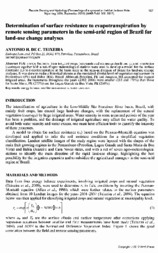Determination of surface resistance to evapotranspiration by remote sensing parameters in the semi-arid region of Brazil for land-use change analyses.
Determination of surface resistance to evapotranspiration by remote sensing parameters in the semi-arid region of Brazil for land-use change analyses.
Author(s): TEIXEIRA, A. H. de C.
Summary: Field energy balances frorn irrigated crops (vineyards and mango orchard) and natural vegetation (caatinga) together with a net of agro-rneteorological stations were used to develop a model for lhe surface resistance (r,) to evapotranspiration at the basin scale in the serni-arid region of Brazil for land-use change analyses. It was done to make a historical picture at the municipal-district levei ofvegetation replacement in Pernambuco (PE) and Bahia (BA), Brazil. Although Petrolina, PE and Juazeiro, BA presented the biggest irrigated areas, the incrernents throughout the years (2002-2006) were smaller (213 and 171%) than those for Santa Maria, PE (275%) and for Lagoa Grande da Boa Vista, PE (260%).
Publication year: 2012
Types of publication: Paper in annals and proceedings
Unit: Embrapa Semi-arid Region
Observation
Some of Embrapa's publications are published as ePub files. To read them, use or download one of the following free software options to your computer or mobile device. Android: Google Play Books; IOS: iBooks; Windows and Linux: Calibre.
Access other publications
Access the Agricultural Research Database (BDPA) to consult Embrapa's full library collection and records.
Visit Embrapa Bookstore to purchase books and other publications sold by Embrapa.

